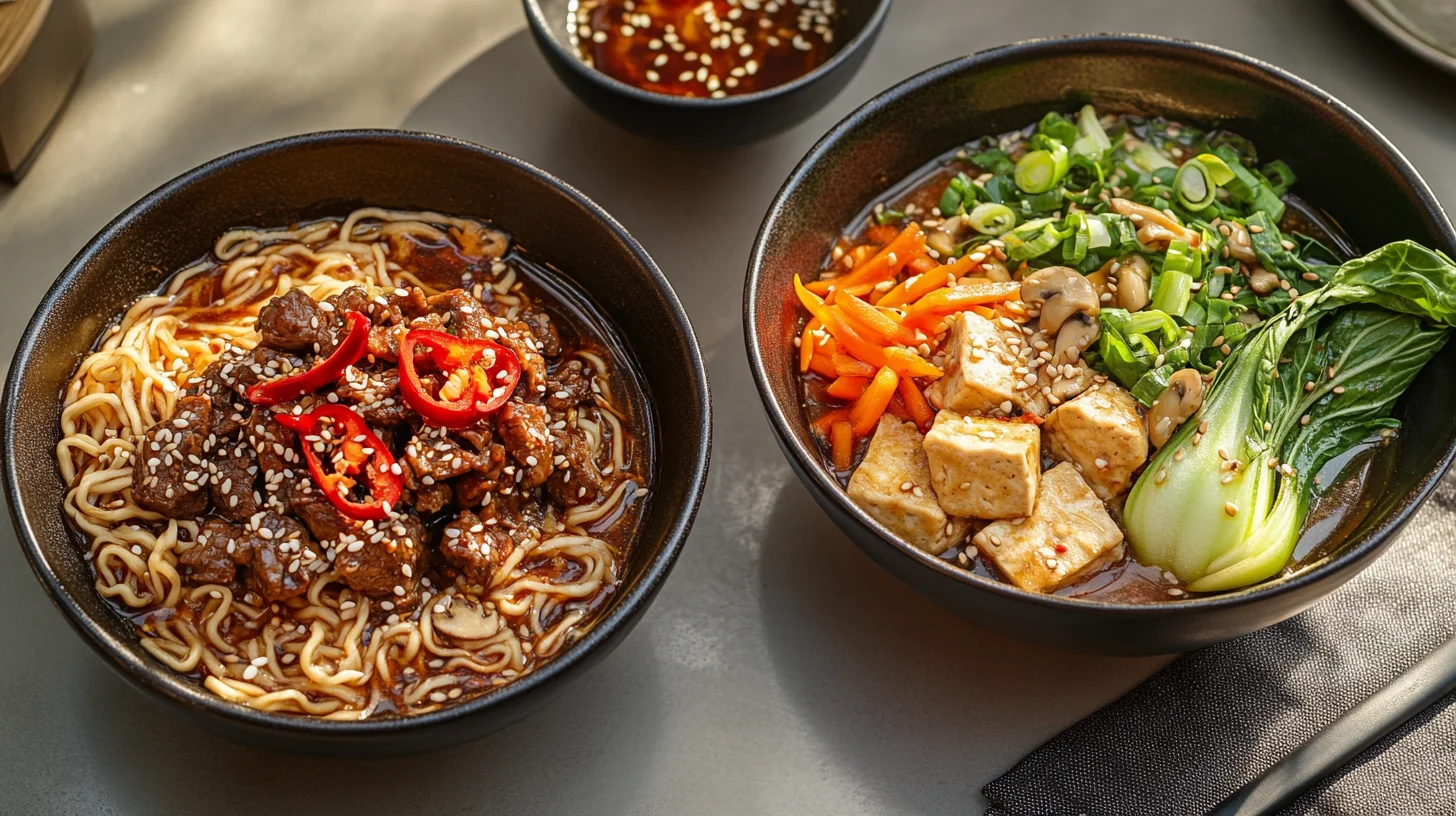If you’re craving a dish that hits that perfect sweet, salty, savory spot and comes together in less than 30 minutes, then Sticky Beef Noodles are your new weeknight hero. Imagine tender slices of beef coated in a rich, glossy sauce that clings to every strand of noodle, infused with garlic, ginger, and a subtle kick of spice — it’s everything you want in a comfort food classic. Plus, it’s wildly customizable, whether you’re cooking for picky eaters or adventurous foodies.
Sticky beef noodles have become a go-to for home cooks around the world — not just because they taste incredible, but also because they’re simple to whip up using pantry staples and fresh ingredients. Whether you’re making them for a quick dinner, prepping lunches for the week, or serving guests something unforgettable, this dish truly delivers.
In this in-depth guide, we’ll cover everything you need to know: from choosing the best beef and noodles, to perfecting that sticky, crave-worthy sauce. We’ll also throw in expert tips, healthy swaps, storage hacks, and delicious variations to make this dish your own.
By the end of this article, you’ll not only master Sticky Beef Noodles but also gain the confidence to adapt it to your taste — spicy, sweet, loaded with veggies, or low-carb. So let’s jump right into this flavor-packed adventure!

What Are Sticky Beef Noodles?
Sticky beef noodles are a savory stir-fried noodle dish that combines thinly sliced beef with a luscious, sticky sauce made from soy, sugar, aromatics, and sometimes hoisin or oyster sauce. The sauce is the star of the show — thick enough to coat the noodles and beef evenly, yet balanced in flavor so it’s not overpowering.
The Origins of Sticky Beef Noodles
While you won’t find a one-size-fits-all origin story, sticky beef noodles draw heavy inspiration from Chinese stir-fry traditions, particularly Cantonese and Sichuan-style cooking. These cuisines are known for bold sauces, tender proteins, and quick wok-fried methods. Over time, the dish evolved, adapting to Western pantries and busy weeknight routines — which is why you’ll see versions with udon noodles, sirloin cuts, and sweet chili sauce on modern recipe blogs.
Why They’ve Become a Global Favorite
Why do sticky beef noodles enjoy such cult-favorite status? Here are a few reasons:
- Speed: You can make them in under 30 minutes.
- Flavor Explosion: Umami-rich, a touch sweet, and deeply satisfying.
- One-Pan Wonder: Minimal cleanup for max reward.
- Versatility: Works with different proteins, veggies, and noodles.
- Crowd-Pleaser: Kids, teens, and adults love it alike.
If you’re looking for that magic combo of convenience and comfort food, this dish checks every box.
Craving similar sticky, savory goodness? Check out this delicious Sweet Chili Chicken Recipe that’s also ready in just a few steps and loaded with flavor.
Key Ingredients for Sticky Beef Noodles
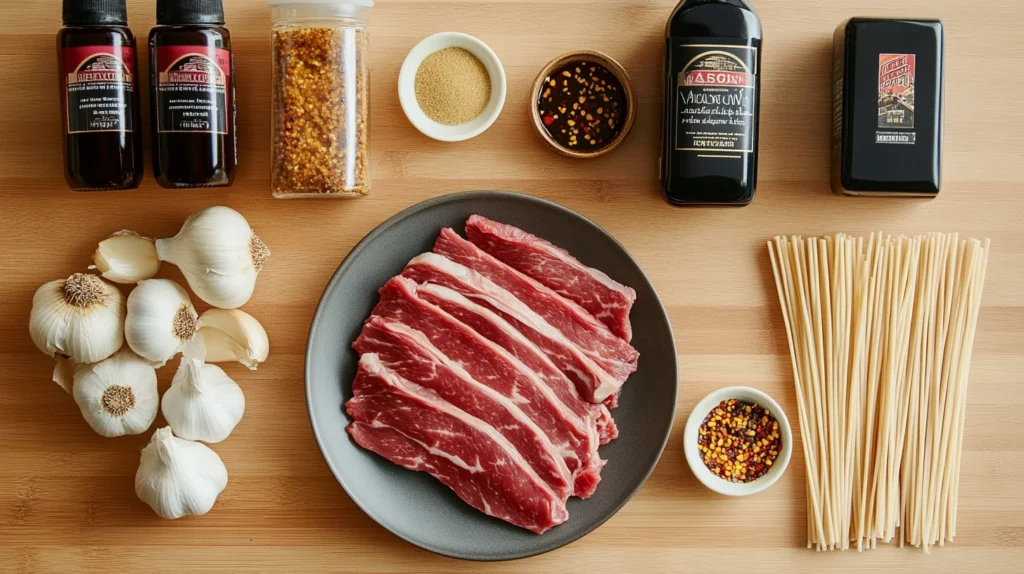
Getting sticky beef noodles just right starts with choosing the right ingredients. From the cut of beef to the kind of noodles and the balance of sweet and salty in the sauce — every element plays a role in building bold, unforgettable flavor. Let’s break down the core components and explore the best options for each.
Best Cuts of Beef to Use
The texture and tenderness of your beef can make or break this dish. The goal is beef that’s juicy, tender, and slices up easily for quick stir-frying. Here are some great options:
- Flank Steak: Lean and flavorful, flank steak slices beautifully across the grain. It soaks up marinades well and cooks fast without getting tough.
- Skirt Steak: Similar to flank but a bit more marbled. It’s perfect for a richer beef flavor and quick searing.
- Sirloin or Rump Steak: Slightly thicker cuts, but still great for slicing into thin strips. They’re also budget-friendly and tender if cooked quickly.
- Ribeye (for indulgence): If you want ultra-tender beef with a luxurious bite, ribeye is an excellent (though more expensive) choice.
Pro Tip: Whatever cut you choose, slice the beef thinly against the grain. This shortens the muscle fibers, making every bite super tender.
From flank steak to ribeye, choosing the right cut makes all the difference. For example, sirloin is a great choice — as also highlighted in this juicy and herbaceous Herb Marinated Sirloin Steaks Recipe, which shows just how flavorful this cut can be when prepared properly.
Essential Noodles: Rice, Egg or Udon?
The noodles you choose can completely change the feel of the dish — from light and chewy to hearty and slurp-worthy.
- Rice Noodles: Light, gluten-free, and absorb sauces well. They give a clean, slightly bouncy bite and pair well with a lighter sauce.
- Egg Noodles: Classic choice for many stir-fries. They’re springy, rich, and hold up well to sticky sauces without falling apart.
- Udon Noodles: Thick, chewy, and deeply satisfying. These are ideal if you like a more substantial noodle base.
- Ramen Noodles (Instant or Fresh): A fun twist — they soak up the sticky sauce and add a playful slurp factor.
Quick Note: Always cook noodles just shy of done before adding to the stir-fry — they’ll finish cooking in the sauce and stay perfectly firm.
Sticky Sauce Breakdown
The sauce is where the magic happens. A good sticky beef noodle sauce is glossy, thick enough to cling to the noodles, and packed with layers of umami and sweetness.
Soy Sauce Variants
- Light Soy Sauce: Salty and fragrant — it forms the base of most sticky sauces.
- Dark Soy Sauce: Adds deeper color and caramel-like flavor.
- Tamari or Coconut Aminos: Perfect gluten-free alternatives that bring similar depth.
Use a mix of light and dark soy sauce to get both brightness and rich undertones.
Sweeteners: Brown Sugar, Honey or Hoisin?
Sweetness balances out the saltiness and enhances the sticky texture.
- Brown Sugar: The go-to for that deep, molasses flavor and stickiness.
- Honey or Maple Syrup: Adds natural sweetness and a lovely sheen.
- Hoisin Sauce: A thick, fragrant sauce that’s both sweet and savory — often used in Chinese BBQ. It brings body and complexity to your base sauce.
Aromatics: Garlic, Ginger, Chili
No stir-fry is complete without aromatics. These build the flavor foundation:
- Garlic: Sharp, earthy, and sweet when cooked.
- Ginger: Bright, slightly spicy, and adds warmth.
- Chili Flakes or Fresh Chili: Add heat and complexity.
For a fragrant kick, sauté these in a little sesame oil before adding the beef and sauce.
This trio — beef, noodles, and sticky sauce — forms the holy trinity of sticky beef noodles. Once you’ve mastered this combo, you can tweak it endlessly to match your mood or diet.
How to Make Sticky Beef Noodles: Step-by-Step Recipe
Ready to bring it all together? This section walks you through the full process of making sticky beef noodles at home — from prepping your ingredients to building that irresistible sticky sauce and serving it hot and fresh. The method is fast and flexible, so once you get the hang of it, you’ll be making this dish on autopilot.
Preparing the Ingredients
Start with mise en place — which means getting everything prepped and ready before you fire up the stove. Stir-fries move fast, and having all your ingredients at arm’s length makes cooking a breeze.
You’ll Need:
- 250–300g beef (flank, skirt, or sirloin) – sliced thinly across the grain
- 200g noodles – egg, rice, or udon (pre-cooked)
- 2 tablespoons light soy sauce
- 1 tablespoon dark soy sauce
- 1 tablespoon hoisin sauce
- 1 tablespoon brown sugar or honey
- 1 tablespoon oyster sauce (optional for depth)
- 2–3 garlic cloves, minced
- 1 tablespoon fresh ginger, minced
- 1 teaspoon chili flakes or 1 fresh red chili, sliced
- 1 tablespoon sesame oil or neutral oil
- 1 teaspoon cornstarch (to thicken the sauce)
- ¼ cup water or beef stock
Optional add-ins:
- Sliced scallions, sesame seeds, shredded carrots, baby bok choy, bell peppers
Cooking the Beef Perfectly
Thinly sliced beef cooks lightning fast, so high heat and speed are key.
- Marinate (optional but recommended): Toss beef with 1 tbsp light soy sauce, ½ tsp cornstarch, and a dash of sesame oil. Let it rest for 10–15 minutes.
- Heat your pan or wok until smoking hot.
- Add a tablespoon of oil, then the beef. Spread it out and let it sear undisturbed for 1 minute to get those crispy edges.
- Stir-fry for another 1–2 minutes until just cooked through. Remove and set aside to avoid overcooking.
Pro Tip: Crowding the pan = steaming, not searing. If needed, cook the beef in batches.
Making the Sticky Sauce
The sauce brings everything together — thick, glossy, and flavor-packed.
- In a small bowl, combine:
- 1 tbsp hoisin
- 1 tbsp brown sugar or honey
- 1 tbsp dark soy sauce
- 1 tbsp light soy sauce
- 1 tbsp oyster sauce (optional)
- ¼ cup water or beef stock
- ½ tsp cornstarch
- Whisk until smooth and lump-free.
- In the same pan you used for the beef, add a little more oil if needed. Sauté minced garlic, ginger, and chili for 30–45 seconds until fragrant.
- Pour in the sauce mixture and let it bubble and thicken — this usually takes 2–3 minutes. Stir occasionally to prevent sticking.
Tossing It All Together
Now the fun part — bringing everything together in a sticky, savory mess of flavor.
- Add your pre-cooked noodles to the pan with the sauce. Toss well to coat every strand.
- Return the cooked beef to the pan and stir-fry everything together for 1–2 minutes until heated through.
- Garnish with scallions, toasted sesame seeds, or even a drizzle of chili oil for that extra kick.
Serve hot — and prepare to watch it disappear in minutes!
Pro Tips for Maximum Flavor
- High heat is key. Use a wok or heavy skillet for even cooking and char.
- Don’t over-sauce the noodles. Sticky sauce should coat, not drown.
- Let the beef rest. A short rest after cooking helps retain juiciness.
- Customize as you go. More spice? Add chili oil. More sweet? Try extra hoisin. Want crunch? Toss in veggies.
Sticky beef noodles are all about quick cooking and big flavor. Once you learn this flow, you’ll be able to freestyle your own creations in no time.
Variations You’ll Love
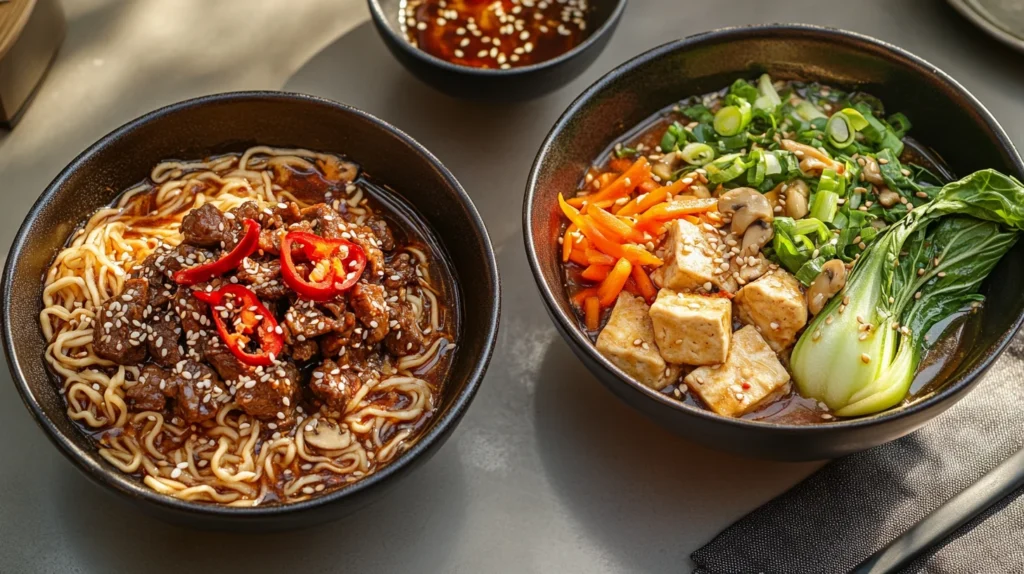
Sticky beef noodles are already a winner, but what makes them even better is their flexibility. You can easily tweak the base recipe to suit your mood, dietary needs, or what’s in your fridge. Whether you’re craving a fiery kick, a veggie-loaded version, or a plant-based alternative, the possibilities are endless.
Spicy Sticky Beef Noodles
If you’re a spice lover, then a hot version of this dish is going to become your obsession. Here’s how to turn up the heat while keeping the flavors balanced.
Ways to Add Spice:
- Fresh Chili: Sliced red Thai chilis or jalapeños for a bright, fiery punch.
- Chili Garlic Sauce (like Sambal Oelek): Adds body and deep, fermented heat.
- Szechuan Peppercorns: A floral, tingling spice from Chinese cuisine.
- Chili Oil or Chili Crisp: A drizzle over the top adds both flavor and texture.
Pro Tip: Don’t just toss in spice for the sake of heat — blend it into the sauce or stir-fry with aromatics so it becomes part of the flavor base.
Sticky Beef with Broccoli or Bok Choy
Adding greens is a great way to boost nutrition and give the dish more body and color. Plus, they absorb that sticky sauce like a dream.
Best Veggies to Use:
- Broccoli Florets: Blanch or steam lightly before stir-frying.
- Bok Choy: Baby bok choy adds crunch and subtle bitterness.
- Snow Peas or Sugar Snap Peas: Crisp and slightly sweet.
- Bell Peppers & Carrots: For color, crunch, and natural sweetness.
How to Add Them:
- Stir-fry veggies briefly before adding noodles.
- Cook in batches to avoid overcrowding and preserve texture.
- Adjust sauce quantity slightly to coat added veggies evenly.
This version is perfect for a more balanced one-pan meal and ideal for kids who need a little veggie sneak-in.
Vegetarian or Vegan Twist
Yes — sticky noodles without the beef can still be absolutely drool-worthy. Just swap in plant-based ingredients that soak up flavor and provide a satisfying bite.
Great Protein Alternatives:
- Tofu (Extra-Firm): Pan-fry cubes until golden before adding to the sauce.
- Tempeh: A nutty, dense soy product that holds up well in stir-fries.
- Mushrooms (Shiitake, Portobello, Oyster): Naturally umami-rich and meaty in texture.
- Seitan or Meatless Strips: Ideal for a chewy, beef-like texture.
Sauce Notes:
- Stick to the same base recipe, but consider adding a dash of mushroom soy sauce or a spoon of miso for an extra umami boost.
This version is great for Meatless Mondays or anyone looking to cut down on animal products without sacrificing taste.
Bonus: Fun Add-In Ideas
Here are some extra ingredients that pair beautifully with sticky beef noodles:
- Crushed peanuts or cashews – for crunch
- Fresh herbs like cilantro or Thai basil – for brightness
- Pickled vegetables – for contrast
- Lime wedges – a squeeze of acidity cuts through richness
These creative spins are proof that sticky beef noodles are more than just a recipe — they’re a flavor canvas you can play with endlessly.
What to Serve with Sticky Beef Noodles
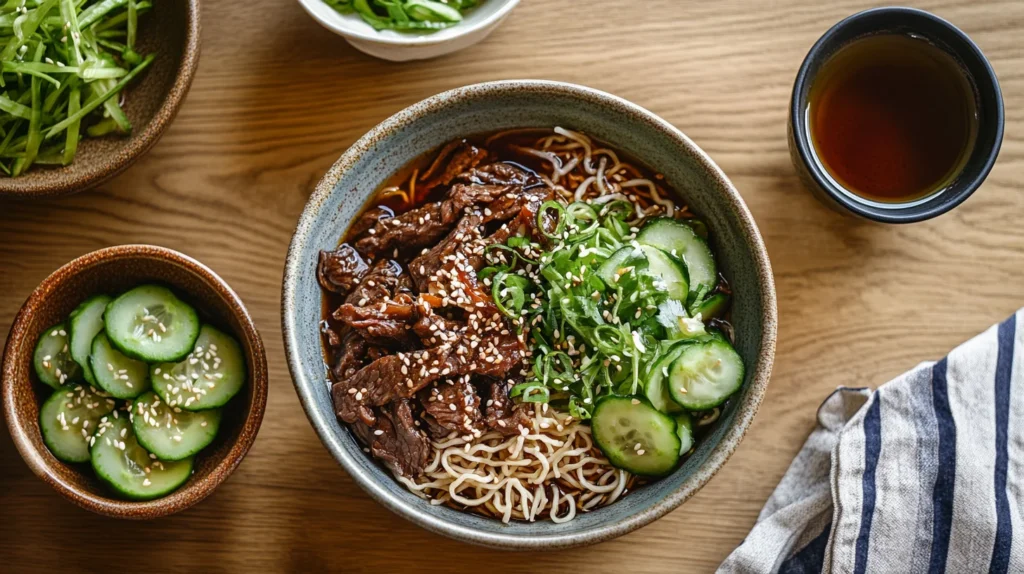
Sticky beef noodles are a star on their own, but they also shine when paired with the right sides and drinks. Whether you’re making it for a casual dinner or a fancier meal, these pairings will round out your dish beautifully.
Sides and Drinks That Complement the Dish
Because the noodles are rich and flavorful, you’ll want sides that add freshness, texture, or contrast. Here are some top recommendations:
Fresh & Crunchy Sides:
- Asian Slaw: Made with cabbage, carrots, sesame oil, and a tangy vinegar dressing. A light, refreshing contrast.
- Cucumber Salad: Thinly sliced cucumbers with rice vinegar, a pinch of sugar, and sesame seeds for crunch and coolness.
- Steamed Edamame: Simply salted or tossed with chili flakes — a protein-packed, salty snack.
Light & Simple Starters:
- Miso Soup: A warm, light broth that won’t overpower the noodles.
- Vegetable Spring Rolls: Crunchy, colorful, and great dipped in sweet chili or soy sauce.
Drink Pairings:
- Green Tea or Jasmine Tea: Cleanses the palate and complements the Asian flavor profile.
- Sparkling Water with Lime: Adds a refreshing citrus touch.
- Dry White Wine or Light Beer: Pairs well with sweet and salty notes.
Asian-Inspired Garnishes
A dish like sticky beef noodles can go from good to gourmet with the right finishing touches.
Garnish Ideas:
- Toasted Sesame Seeds: Add nutty flavor and slight crunch.
- Sliced Scallions: Brings freshness and a bit of bite.
- Fresh Cilantro or Thai Basil: For herbal brightness.
- Chili Oil or Crispy Shallots: For texture and extra punch.
- Crushed Peanuts or Cashews: For crunch and depth.
Garnishes are also a great way to let guests personalize their bowls — especially if you’re hosting a DIY noodle bar night!
Storage and Reheating Tips
Made a big batch? No problem. Sticky beef noodles are great for meal prep and hold up surprisingly well — as long as you store and reheat them properly.
How Long Do They Last?
- Refrigerate in an airtight container and enjoy within 3 to 4 days for best freshness and flavor.
- Freezer: You can freeze sticky beef noodles, but the noodles may soften after thawing. Use within 2 months for best texture.
Tip: Store garnishes separately to keep them fresh and crisp.
Best Ways to Reheat Without Drying Out
Noodles can get gummy if reheated wrong. Here’s how to keep them silky and flavorful:
Stovetop (Best Method):
- Add a splash of water, broth, or soy sauce to the pan.
- Reheat over medium heat, stirring gently until warmed through.
Microwave:
- Place noodles in a microwave-safe container.
- Sprinkle with a little water or sauce.
- Cover with a damp paper towel and heat in 30-second bursts, stirring in between.
Avoid overcooking — just heat until hot. Overheating can turn your beef rubbery and noodles mushy.
Common Mistakes to Avoid
Even a simple dish like sticky beef noodles can go sideways without the right techniques. Or for a slightly more casual yet helpful tone:
Overcooking the Beef
Thin slices of beef cook in 2 minutes or less. Any longer and you risk tough, chewy results. Always slice against the grain and cook on high heat for that perfect sear.
Sauce That’s Too Runny or Too Thick
Sticky sauce should coat the noodles, not pool at the bottom or turn into glue.
- Too runny? Add a cornstarch slurry (1 tsp cornstarch + 1 tbsp water).
- Too thick? Loosen with water or broth, a tablespoon at a time.
Tip: Let the sauce simmer for 1–2 minutes to naturally thicken before adding noodles.
Noodles Sticking or Overcooking
This often happens when:
- Noodles are overcooked before stir-frying.
- They’re added to a dry pan without enough sauce or oil.
- You don’t stir quickly enough once they hit the heat.
Fix: Cook noodles just al dente, toss with oil after boiling, and stir-fry quickly to coat evenly.
Avoiding these simple mistakes will help ensure your sticky beef noodles come out perfect — every single time.
Frequently Asked Questions
How many days is beef and noodles good for?
Sticky beef noodles can be safely stored in the refrigerator for up to 3–4 days. Be sure to let them cool completely before transferring them into an airtight container. Keep them refrigerated at or below 40°F (4°C). When reheating, ensure they are piping hot throughout to maintain food safety and best taste.
How long can you freeze beef and noodles?
You can freeze sticky beef noodles for up to 2 months. While the beef and sauce hold up well, be aware that some noodle types (like rice noodles) may soften or break down slightly upon thawing. To freeze, portion into freezer-safe containers or zip bags, squeeze out excess air, and label with the date. Thaw overnight in the fridge before reheating gently on the stovetop or in the microwave with a splash of water or broth.
How can I thicken my beef and noodles?
If your sticky sauce ends up too runny, the simplest way to thicken it is by using a cornstarch slurry:
Mix 1 teaspoon cornstarch with 1 tablespoon cold water until smooth.
Pour it into the simmering sauce and stir continuously for 1–2 minutes until it thickens and turns glossy.
Alternatively, reduce the sauce on medium heat until it naturally thickens. Just make sure you stir to prevent burning and adjust seasoning afterward if needed.
How to make noodles non-sticky?
Sticky noodles (in the bad way!) usually result from overcooking or starch clumping. Here’s how to avoid that:
Cook noodles just until al dente. Slightly undercook them so they finish cooking in the sauce.
Rinse rice or egg noodles briefly under cold water after boiling to remove surface starch (unless package directions say otherwise).
Toss noodles with a little oil after draining — especially if you’re not using them immediately.
When adding to the pan, stir-fry quickly so they’re coated evenly in sauce and don’t clump together.
These simple steps help ensure smooth, slurp-worthy noodles every time!
Conclusion
Sticky beef noodles are the perfect combination of convenience, comfort, and full-bodied flavor. Whether you’re looking for a quick weeknight meal or a dish to impress your dinner guests, this stir-fried favorite never disappoints. With just a few pantry staples and fresh ingredients, you can bring bold Asian-inspired flavors into your kitchen in under 30 minutes.
From mastering the sauce to choosing the right cut of beef and noodles, this recipe gives you all the tools you need to create restaurant-quality results at home. The best part? You can customize it to your taste — spicy, sweet, veggie-packed, or even meatless.
Now that you know how to make it from scratch, store it, reheat it, and remix it with variations, there’s nothing stopping you from turning this dish into a household favorite. Bookmark this recipe, experiment with different versions, and don’t forget to garnish for that final pop of flavor.
Sticky beef noodles are more than just a quick dinner — they’re a celebration of texture, taste, and simplicity all in one bowl.
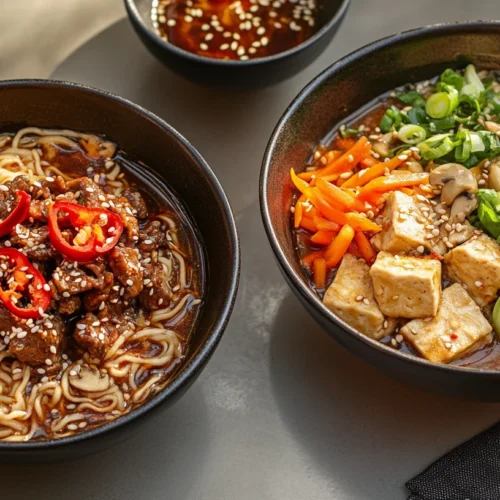
Sticky Beef Noodles
Equipment
- Wok or large skillet
- Sharp knife
- Cutting board
- Mixing bowls
- Tongs or chopsticks
- Sauce whisk or spoon
Ingredients
- For the Beef & Marinade:
- 250 g flank or sirloin steak thinly sliced against the grain
- 1 tbsp light soy sauce
- ½ tsp cornstarch
- 1 tsp sesame oil
- For the Sauce:
- 1 tbsp hoisin sauce
- 1 tbsp oyster sauce optional for depth
- 1 tbsp brown sugar or honey
- 1 tbsp dark soy sauce
- 1 tbsp light soy sauce
- ¼ cup water or beef broth
- ½ tsp cornstarch to thicken
- Stir-Fry Ingredients:
- 200 g cooked egg noodles or rice noodles
- 1 tbsp sesame or vegetable oil
- 2 garlic cloves minced
- 1 tbsp ginger minced
- 1 tsp chili flakes optional
- Sliced scallions and sesame seeds for garnish
Instructions
- Marinate the Beef:
- In a bowl, combine sliced beef, soy sauce, cornstarch, and sesame oil. Let it marinate for 10–15 minutes while prepping the other ingredients.
- Make the Sauce:
- Whisk together all sauce ingredients in a small bowl and set aside.
- Cook the Beef:
- Heat a wok or skillet over high heat. Add oil, then the marinated beef. Sear for 1–2 minutes until browned. Remove and set aside.
- Sauté Aromatics:
- In the same pan, add a bit more oil if needed. Sauté garlic, ginger, and chili flakes for 30–45 seconds.
- Add Sauce and Noodles:
- Pour in the sauce and bring to a simmer. Let it thicken for 1–2 minutes. Add noodles and toss to coat.
- Combine & Serve:
- Return beef to the pan and stir-fry everything together for 1–2 more minutes. Serve hot, garnished with scallions and sesame seeds.
Notes
Swap beef for tofu or mushrooms for a vegetarian option.
Adjust chili level to taste or leave it out for a mild version.
Add broccoli, bok choy, or bell peppers for extra veggies.
Great for meal prep — just store in an airtight container for up to 4 days.

